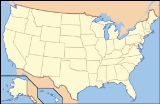
Innoko National Wildlife Refuge
Encyclopedia
The Innoko National Wildlife Refuge is a wildlife refuge
in western Alaska
in the United States
. It consists of 3,850,481 acres (15,582 km2) of which 1,240,000 acres (5,018 km2) is designated a wilderness area. It is the fifth-largest National Wildlife Refuge in the United States. The refuge is administered from offices in McGrath
.
The wildlife refuge is in two parts. The northern part of the refuge, called Kaiyah Flats, is adjacent to the Yukon River
southwest of Galena, Alaska
. It contains 751,000 acres (3,040 km2). The southern part of the refuge contains approximately 3,099,000 acres (12,540 km2) of land surrounding the Innoko River
. The land is swampy and is the nesting area for hundreds of thousands of birds and the home of black bears
, moose
, wolves and other furred mammals.
The refuge was established in 1980 by the Alaska National Interest Lands Conservation Act
.
The refuge has no road access from outside and contains no roads. Air access can be arranged through McGrath, Alaska
.
Wildlife refuge
A wildlife refuge, also called a wildlife sanctuary, may be a naturally occurring sanctuary, such as an island, that provides protection for species from hunting, predation or competition, or it may refer to a protected area, a geographic territory within which wildlife is protected...
in western Alaska
Alaska
Alaska is the largest state in the United States by area. It is situated in the northwest extremity of the North American continent, with Canada to the east, the Arctic Ocean to the north, and the Pacific Ocean to the west and south, with Russia further west across the Bering Strait...
in the United States
United States
The United States of America is a federal constitutional republic comprising fifty states and a federal district...
. It consists of 3,850,481 acres (15,582 km2) of which 1,240,000 acres (5,018 km2) is designated a wilderness area. It is the fifth-largest National Wildlife Refuge in the United States. The refuge is administered from offices in McGrath
McGrath, Alaska
As of the census of 2000, there were 401 people, 145 households, and 99 families residing in the city. The population density was 8.2 people per square mile . There were 213 housing units at an average density of 4.4 per square mile...
.
The wildlife refuge is in two parts. The northern part of the refuge, called Kaiyah Flats, is adjacent to the Yukon River
Yukon River
The Yukon River is a major watercourse of northwestern North America. The source of the river is located in British Columbia, Canada. The next portion lies in, and gives its name to Yukon Territory. The lower half of the river lies in the U.S. state of Alaska. The river is long and empties into...
southwest of Galena, Alaska
Galena, Alaska
Galena is the largest city in the Yukon-Koyukuk Census Area in the U.S. state of Alaska. At the 2000 census the population was 675.-History:...
. It contains 751,000 acres (3,040 km2). The southern part of the refuge contains approximately 3,099,000 acres (12,540 km2) of land surrounding the Innoko River
Innoko River
The Innoko River is a river in western Alaska. It flows north from its origin south of Cloudy Mountain in the Kuskoswim Mountains and then flows southwest to its end at the Yukon River, across from Holy Cross, Alaska....
. The land is swampy and is the nesting area for hundreds of thousands of birds and the home of black bears
American black bear
The American black bear is a medium-sized bear native to North America. It is the continent's smallest and most common bear species. Black bears are omnivores, with their diets varying greatly depending on season and location. They typically live in largely forested areas, but do leave forests in...
, moose
Moose
The moose or Eurasian elk is the largest extant species in the deer family. Moose are distinguished by the palmate antlers of the males; other members of the family have antlers with a dendritic configuration...
, wolves and other furred mammals.
The refuge was established in 1980 by the Alaska National Interest Lands Conservation Act
Alaska National Interest Lands Conservation Act
The Alaska National Interest Lands Conservation Act was a United States federal law passed in 1980 by the U.S. Congress and signed into law by President Jimmy Carter on December 2 of that year....
.
The refuge has no road access from outside and contains no roads. Air access can be arranged through McGrath, Alaska
McGrath, Alaska
As of the census of 2000, there were 401 people, 145 households, and 99 families residing in the city. The population density was 8.2 people per square mile . There were 213 housing units at an average density of 4.4 per square mile...
.
External links
- Official FWS website: Innoko National Wildlife Refuge

